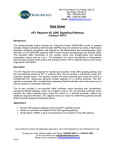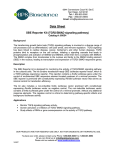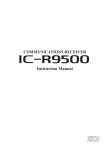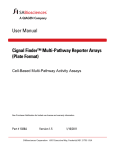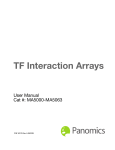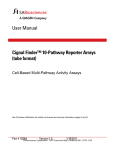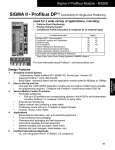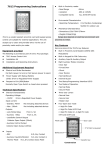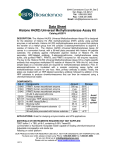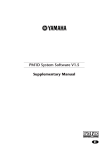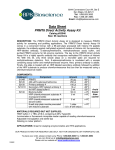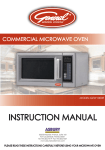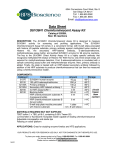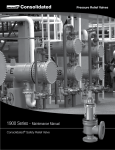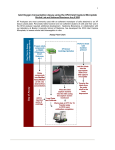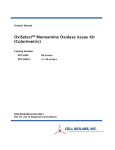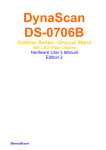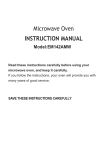Download Data Sheet Notch Pathway Reporter Kit
Transcript
6044 Cornerstone Court W, Ste E San Diego, CA 92121 Tel: 1.858.829.3082 Fax: 1.858.481.8694 Email: [email protected] Data Sheet Notch Pathway Reporter Kit Catalog # 60509 Background The Notch signaling pathway controls cell fate decisions in vertebrate and invertebrate tissues. NOTCH signaling is triggered through the binding of a transmembrane ligand to Notch transmembrane receptor (NOTCH1/ NOTCH2/NOTCH3/NOTCH4) on a neighboring cell. This results in proteolytic cleavage of the NOTCH receptor, releasing the constitutively active intracellular domain of NOTCH (NICD). NICD translocates to the nucleus and associates with transcription factors CSL (CBF1/RBPJκ/Suppressor of Hairless/Lag-1) and coactivator Mastermind to turn on transcription of Notch-responsive genes. Description Notch Pathway Reporter kit is designed for monitoring the activity of the Notch signaling pathway in cultured cells. The kit contains a transfection-ready expression vector for NOTCH1 that has a deletion of the entire extracellular domain (Notch1∆E). Inside the cells, the NOTCH1 ∆E can be cleaved by γ-secretase and active NOTCH1 NICD is released into the nucleus. The kit also contains CSL (CBF1/RBP-Jκ) luciferase reporter vector, which is a Notch pathwayresponsive reporter. This reporter contains the firefly luciferase gene under the control of multimerized CSL responsive elements upstream of a minimal promoter. The CSL (CBF1/RBPJκ) reporter is premixed with constitutively expressing Renilla (sea pansy) luciferase vector, which serves as an internal positive control for transfection efficiency. The kit also includes a non-inducible firefly luciferase vector premixed with constitutivelyexpressing Renilla luciferase vector as a negative control. The non-inducible luciferase vector contains a firefly luciferase gene under the control of a minimal promoter, but without any additional response elements. The negative control is critical for determining pathway specific effects and background luciferase activity. Application • • • Monitor Notch signaling pathway activity. Screen activators or inhibitors of Notch signaling pathway. Study effects of RNAi or gene overexpression on the activity of Notch pathway. OUR PRODUCTS ARE FOR RESEARCH USE ONLY. NOT FOR DIAGNOSTIC OR THERAPEUTIC USE. To place your order, please contact us by Phone 1.858.829.3082 Fax 1.858.481.8694 Or you can Email us at: [email protected] Please visit our website at: www.bpsbioscience.com 140827 6044 Cornerstone Court W, Ste E San Diego, CA 92121 Tel: 1.858.829.3082 Fax: 1.858.481.8694 Email: [email protected] Components Component Reporter (Component A) Specification CSL (CBF1/RBP-Jκ) luciferase reporter vector + constitutively expressing Renilla luciferase vector Negative Control Non-inducible luciferase vector + Reporter constitutively expressing Renilla (Component B) luciferase vector Expression vector for intracellular Notch1∆ ∆E domain of Notch1 (Component C) Negative Control Empty expression vector without Expression Notch1 vector (Component D) Amount 500 µl (60 ng DNA/ µl) Storage -20°C 500 µl (60 ng DNA/ µl) -20°C 250 µl -20°C (100 ng DNA/µl) 250 µl -20°C (100 ng DNA/µl) These vectors are ready for transient transfection. They are NOT SUITBLE for transformation and amplification in bacteria. Materials Required but Not Supplied • • • • • • Mammalian cell line and appropriate cell culture medium 96-well tissue culture plate or 96-well tissue culture treated white clear-bottom assay plate (Corning # 3610) Transfection reagent for mammalian cell line [We use Lipofectamine™ 2000 (Invitrogen # 11668027). However, other transfection reagents should work equally well.] Opti-MEM I Reduced Serum Medium (Invitrogen #31985-062) Dual luciferase assay system: Dual-Glo® Luciferase Assay System (Promega #E2920): This system assays cells directly in growth medium. It can be used with any luminometer. Automated injectors are not required. OR Dual-Luciferase® Reporter Assay System (Promega #E1910): This system requires a cell lysis step. It is ideal for luminometers with automated injectors. Luminometer OUR PRODUCTS ARE FOR RESEARCH USE ONLY. NOT FOR DIAGNOSTIC OR THERAPEUTIC USE. To place your order, please contact us by Phone 1.858.829.3082 Fax 1.858.481.8694 Or you can Email us at: [email protected] Please visit our website at: www.bpsbioscience.com 140827 6044 Cornerstone Court W, Ste E San Diego, CA 92121 Tel: 1.858.829.3082 Fax: 1.858.481.8694 Email: [email protected] Generalized Transfection and Assay Protocols The following procedure is designed to transfect the reporter into HEK293 cells using Lipofectamine 2000 in a 96-well format. To transfect cells in different tissue culture formats, adjust the amounts of reagents and cell number in proportion to the relative surface area. If using a transfection reagent other than Lipofectamine 2000, follow the manufacturer’s transfection protocol. Transfection condition should be optimized according to the cell type and study requirements. All amounts and volumes in the following setup are given on a per well basis. 1. One day before transfection, seed cells at a density of ~ 30,000 cells per well in 100 µl of growth medium so that cells will be 90% confluent at the time of transfection. 2. Next day, for each well, prepare complexes as follows: a. Dilute DNA mixtures in 15 µl of Opti-MEM I medium (antibiotic-free). Mix gently. Depending upon the experimental design, the DNA mixtures may be any of the following combinations: • 1 µl of Reporter (component A); in this experiment, the control transfection is 1 µl of Negative Control Reporter (component B). • 1 µl of Reporter (component A) + experimental vector expressing gene of interest (such as component C); in this experiment, the control transfections are: 1 µl of Reporter (component A) + negative control expression vector (such as component D), 1 µl of Negative Control Reporter (component B) + experimental vector expressing gene of interest, and 1 µl of Negative Control Reporter (component B) + negative control expression vector. • 1 µl of Reporter (component A) + specific siRNA; in this experiment, the control transfections are: 1 µl of Reporter (component A) + negative control siRNA, 1 µl of Negative Control Reporter (component B) + specific siRNA, and 1 µl of Negative Control Reporter (component B) + negative control siRNA. Note: we recommend setting up each condition in at least triplicate, and prepare transfection cocktail for multiple wells. b. Mix Lipofectamine 2000 gently before use, then dilute 0.35 µl of Lipofectamine 2000 in 15 µl of Opti-MEM I medium (antibiotic-free). Incubate for 5 minutes at room temperature. Note: Prepare this dilution cocktail in volumes sufficient for the whole experiment. b. After the 5 minute incubation, combine the diluted DNA with diluted Lipofectamine 2000. Mix gently and incubate for 25 minutes at room temperature. OUR PRODUCTS ARE FOR RESEARCH USE ONLY. NOT FOR DIAGNOSTIC OR THERAPEUTIC USE. To place your order, please contact us by Phone 1.858.829.3082 Fax 1.858.481.8694 Or you can Email us at: [email protected] Please visit our website at: www.bpsbioscience.com 140827 6044 Cornerstone Court W, Ste E San Diego, CA 92121 Tel: 1.858.829.3082 Fax: 1.858.481.8694 Email: [email protected] 3. Add the 30 µl of complexes to each well containing cells and medium. Mix gently by tapping the plate. 4. Incubate cells at 37°C in a CO2 incubator. After ~24 hours of transfection, change medium to fresh growth medium. ~48 hours after transfection, perform the dual luciferase assay following the manufacturer’s protocol. To study the effect of activators / inhibitors on the Notch pathway, treat the cells with tested activator/inhibitor after ~6 hours or 24 hours of transfection. Perform dual luciferase assay ~48 hours after transfection. Sample protocol to determine the effect of NOTCH 1 on the CSL (CBF1/RBP-Jκ κ) reporter in HEK293 cells 1. One day before transfection, seed HEK293 cells at a density of 30,000 cells per well into white clear-bottom 96-well plate in 100 µl of growth medium (MEM/EBSS (Hyclone #SH30024.01) , 10% FBS, 1% non-essential amino acids, 1 mM Na-pyruvate, 1% Pen/Strep). Incubate cells at 37°C in a CO2 incubator overnight. 2. Next day, transfect 1 µl of CSL (CBF1/RBP-Jκ) luciferase reporter (component A) with 0.5 µl of Notch1∆E (component C) or negative control expression vector (component D) into cells following the procedure in Generalized Transfection and Assay Protocols. 3. After ~24 hours of transfection, change medium to 50 µl of fresh growth medium. Add 50 µl of growth medium to cell-free control wells (for determining background luminescence). 4. After ~48 hours of transfection, perform dual luciferase assay using Dual-Glo® Luciferase Assay System (Promega #E2920): Add 50 µl of Luciferase reagent per well and rock at room temperature for ~15 minutes, then measure firefly luminescence using a luminometer. Add 50 µl of Stop & Glo reagent per well. Rock at room temperature for ~15 minutes and measure Renilla luminescence. 5. To obtain the normalized luciferase activity for CSL (CBF1/RBP-Jκ) reporter, subtract background luminescence, then calculate the ratio of firefly luminescence from CSL (CBF1/RBP-Jκ) reporter to Renilla luminescence from the control Renilla luciferase vector. OUR PRODUCTS ARE FOR RESEARCH USE ONLY. NOT FOR DIAGNOSTIC OR THERAPEUTIC USE. To place your order, please contact us by Phone 1.858.829.3082 Fax 1.858.481.8694 Or you can Email us at: [email protected] Please visit our website at: www.bpsbioscience.com 140827 6044 Cornerstone Court W, Ste E San Diego, CA 92121 Tel: 1.858.829.3082 Fax: 1.858.481.8694 Email: [email protected] Figure 1. Notch1∆ ∆E induced the expression of CSL (CBF1/RBP-Jκ κ) reporter. The results are shown as normalized CSL (CBF1/RBP-Jκ) luciferase reporter activity. Sample protocol to determine the effect of antagonists of Notch signaling pathway on Notch1∆ ∆E-induced CSL (CBF1/RBP-Jκ κ) reporter activity in HEK293 cells: 1. One day before transfection, seed HEK293 cells at a density of 30,000 cells in 100 µl of growth medium into each well of a white clear-bottom 96-well plate. Incubate cells at 37°C in a CO2 incubator overnight. 2. Next day, transfect 1 µl of CSL (CBF1/RBP-Jκ) luciferase reporter (component A) with 0.5 µl of Notch1∆E (component C) into cells following the procedure in Generalized Transfection and Assay Protocols. 3. After ~24 hours of transfection, treat transfected cells with the Notch pathway inhibitor DAPT (γ-secretase inhibitor) in 50 µl of fresh growth medium. Add 50 µl of growth medium to cell-free control wells (for determining background luminescence). Set up each treatment in at least triplicate. Incubate cells at 37°C in a CO2 incubator for ~24 hours. 4. After ~48 hours of transfection, perform dual luciferase assay using Dual-Glo® Luciferase Assay System: Add 50 µl of Luciferase reagent per well and rock at room temperature for ~15 minutes, then measure firefly luminescence using a luminometer. Add 50 µl of Stop & OUR PRODUCTS ARE FOR RESEARCH USE ONLY. NOT FOR DIAGNOSTIC OR THERAPEUTIC USE. To place your order, please contact us by Phone 1.858.829.3082 Fax 1.858.481.8694 Or you can Email us at: [email protected] Please visit our website at: www.bpsbioscience.com 140827 6044 Cornerstone Court W, Ste E San Diego, CA 92121 Tel: 1.858.829.3082 Fax: 1.858.481.8694 Email: [email protected] Glo reagent per well. Rock at room temperature for ~15 minutes and measure Renilla luminescence. 5. To obtain the normalized luciferase activity for CSL (CBF1/RBP-Jκ) reporter, subtract background luminescence, then calculate the ratio of firefly luminescence from CSL (CBF1/RBP-Jκ) reporter to Renilla luminescence from the control Renilla luciferase vector. Figure 2. Inhibition of Notch1∆ ∆E-induced CSL (CBF1/RBP-Jκ κ) reporter activity by Notch pathway inhibitor, DAPT (γ-secretase inhibitor). 2a.DAPT completely blocks Notch1∆E-induced CSL (CBF1/RBP-Jκ) reporter activity. The results are shown as normalized CSL (CBF1/RBP-Jκ) luciferase reporter activity. OUR PRODUCTS ARE FOR RESEARCH USE ONLY. NOT FOR DIAGNOSTIC OR THERAPEUTIC USE. To place your order, please contact us by Phone 1.858.829.3082 Fax 1.858.481.8694 Or you can Email us at: [email protected] Please visit our website at: www.bpsbioscience.com 140827 6044 Cornerstone Court W, Ste E San Diego, CA 92121 Tel: 1.858.829.3082 Fax: 1.858.481.8694 Email: [email protected] 2b.Dose response of Notch1∆E-induced CSL (CBF1/RBP-Jκ) reporter activity to DAPT. The results are shown as percentage of CSL (CBF1/RBP-Jκ) reporter activity. The normalized luciferase activity for Notch1∆E transfected cells without DAPT treatment was set at 100%. The IC50 of DAPT is ~ 0.11 µM. References Lu FM et al. (1996) Constitutively active human Notch1 binds to the transcription factor CBF1 and stimulates transcription through a promoter containing a CBF1-responsive element. Proc. Natl. Acad. Sci. USA 93(11): 5663-5667. Kanungo, et al. (2008) The Notch signaling inhibitor DAPT down-regulates cdk5 activity and modulates the distribution of neuronal cytoskeletal proteins. J. Neurochem. 106: 2236. OUR PRODUCTS ARE FOR RESEARCH USE ONLY. NOT FOR DIAGNOSTIC OR THERAPEUTIC USE. To place your order, please contact us by Phone 1.858.829.3082 Fax 1.858.481.8694 Or you can Email us at: [email protected] Please visit our website at: www.bpsbioscience.com 140827








